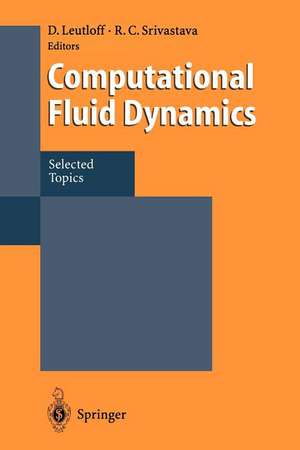Computational Fluid Dynamics: Selected Topics
Editat de Dieter Leutloff, Ramesh C. Srivastavaen Limba Engleză Paperback – 14 dec 2011
Preț: 389.11 lei
Nou
Puncte Express: 584
Preț estimativ în valută:
74.45€ • 77.95$ • 61.61£
74.45€ • 77.95$ • 61.61£
Carte tipărită la comandă
Livrare economică 07-21 aprilie
Preluare comenzi: 021 569.72.76
Specificații
ISBN-13: 9783642794421
ISBN-10: 3642794424
Pagini: 312
Ilustrații: XIX, 287 p.
Dimensiuni: 155 x 235 x 16 mm
Greutate: 0.44 kg
Ediția:Softcover reprint of the original 1st ed. 1995
Editura: Springer Berlin, Heidelberg
Colecția Springer
Locul publicării:Berlin, Heidelberg, Germany
ISBN-10: 3642794424
Pagini: 312
Ilustrații: XIX, 287 p.
Dimensiuni: 155 x 235 x 16 mm
Greutate: 0.44 kg
Ediția:Softcover reprint of the original 1st ed. 1995
Editura: Springer Berlin, Heidelberg
Colecția Springer
Locul publicării:Berlin, Heidelberg, Germany
Public țintă
ResearchCuprins
Continuum Hypothesis in the Computation of Gas-Solid Flows.- 1. Introduction.- 2. Governing Equations.- 3. Numerical Procedure.- 4. Numerical Results.- 5. Conclusions.- Numerical Modelling of Two- and Three-Dimensional External and Internal Unsteady Incompressible Flow Problems.- 1. Introduction.- 2. The Mathematical Model — The Governing Equations.- 3. The Numerical Solution Method.- 4. The Solution of the Equation Systems (3.9) and (3.10) — Solvability Conditions.- 5. The Application of the Solution Methods to Crystal Melt Flow.- 6. The External Flow Around a Cylinder.- Numerical Experiments in Double-Diffusive Convection.- 1. Introduction.- 2. The Motion Equations and Their Numerical Solution.- 3. Lateral Heating of a Stratified Fluid.- 4. Conclusion.- New Potentialities of Computational Experiment in Tsunami Problem.- 1. Introduction.- 2. Basic Mathematical Models.- 3. Methodological Principles of Some Applied Problems of Tsunami by Computational Experiment.- 4. Computational Experiment Facilities Employed for the Training of the Tsunami Warning Service Personnel and of the Population in the Threatened Zones.- General Balance Equations for a Fluid—Fluid Interface in Magnetofluiddynamics Soubbaramayer.- 1. Introduction.- 2. MFD Model: Integral Conservative Form.- 3. Balance Equations for the Interface.- 4. Application to the Calculation of the Surface Depression in a High-Current Arc Weld Pool.- 5. Conclusion.- Group-Invariant Solutions of Hydrodynamics.- 1. Introduction.- 2. Lie Groups Applied to Differential Equations.- 3. Hydrodynamics Model.- 4. One-Dimensional Solutions.- 5. Two-Dimensional Solutions.- 6. 3-D Solutions.- 7. Analytic Solutions.- Survey on Exact Solutions for Discrete Models of the Boltzmann Equation.- 1. Introduction.- 2. Broad wellEquations.- 3. Models with 14 Velocities.- 4. Models with Triple Collisions.- 5. Two-Dimensional Semi-Continuous Model Ill.- 6. Conclusion.- Boundary Conditions for Discrete Models of Gases and Applications to Couette Flows Amah D’Almeida and Renée Gatignol.- 1. Introduction.- 2. Discrete Kinetic Theory.- 3. Boundary Conditions.- 4. Couette Flows.- 5. Results.- 6. Conclusion.- Computation of Viscous Transonic Flow Around the F5 Wing.- 1. Introduction.- 2. Governing Equations and Boundary Conditions.- 3. Numerical Method.- 4. Results.- 5. Conclusions.- A Time-Dependent Space Marching Algorithm for Three-Dimensional PNS Equations.- 1. Introduction.- 2. Governing Equations.- 3. The Flux-Difference Splitting.- 4. Explicit-Implicit Difference Scheme.- 5. Numerical Tests.- 6. Conclusions.- New Potential-Field Properties of General Laminar and Turbulent Motions of Newtonian Fluids.- I. Introduction.- 2. Physical and Mathematical Preliminaries.- 3. Derivation of Some Field Properties of NSE.- 4. Thermo dynamical Stability Criterion for Instationary Flows.- 5. The Instationary Turbulent Flow in Temporal Mean.- 6. Conclusion.- Boundary Layer Turbulence and the Control by Suction.- 1. Introduction.- 2. Flow Change with the Development of Boundary Layer.- 3. Discussion on Energy.- 4. Self-Organization of Turbulent Boundary Layer.- 5. Experiment on Control of Turbulent Boundary Layer.- 6. Conclusions.- On the Quasi-Geostrophic Drag on a Rising Sphere in a Rotating Fluid.- 1. Introduction.- 2. Solution.- 3. Results.- Two-Dimensional Nonlinear Saturation Behaviour of Instability Waves in a Boundary Layer at Mach 5.- 1. Introduction.- 2. Governing Equations.- 3. Numerical Method.- 4. Simulation Results.- 5. Perturbation Evolution.- 6. Evolution of the Flow Field.- 7. ShockIdentification.- 8. Conclusions.- Inertia! Convection in Turbulent Rayleigh-Bénard Convection at Small Prandtl Numbers.- 1. Introduction.- 2. Simulation Method.- 3. Case Specifications and Initial Data.- 4. Results.- 5. Conclusions.- The GRP Treatment of Flow Singularities.- 1. Tracking of Singularities.- 2. Geometrical Singularities.- 3. Narrow Reaction Zones in Combustion Calculations.- Application of the Multidomain Local Fourier Method for CFD in Complex Geometries.- 1. Introduction.- 2. Multidomain Local Fourier Method (MDLF).- 3. Problems in Complex Geometries.- 4. Preconditioned Iteration Method with Spectral Preconditioner.- 5. Demonstration for the Navier-Stokes System.- Confined Swirling Flows - A Continuing Challenge.- 1. Introduction.- 2. Statement of the Problem.- 3. Numerical Formulation.- 4. Results and Discussion.- 5. Conclusions.- Eshelbian Continuum Mechanics and Nonlinear.- 1. Introduction.- 2. Momentum and Pseudo-Momentum; Force and Pseudo-Force.- 3. Field Formulation.- 4. Non-Equivalence Between Global Formulations.- 5. The Role of Pseudomomentum and Energy in Nonlinear-Wave Propagation.- 6. A Newtonian Mechanics for Global Material Forces?.
Textul de pe ultima copertă
Computational methods and modelling is of growing importance in fundamental science as well as in applications in industry and in environmental research. In this topical volume, compiled in honor of Professor K.G. Roesner of the Darmstadt Institute of Technology, the readers find important contributions in the field of turbulent boundary layers, the Tsunami problem, group invariant solution of hydrodynamic equations, non-linear waves, modelling of the problem of evaporation-condensation, the exact solution of discrete models of the Boltzmann equation etc. The book addresses researchers and engineers both in the mechanical sciences and in scientific computing.














